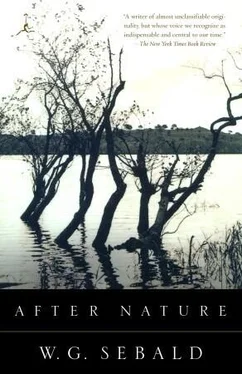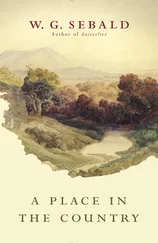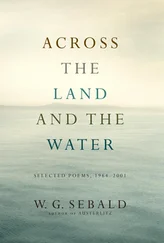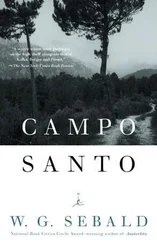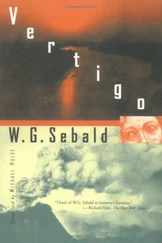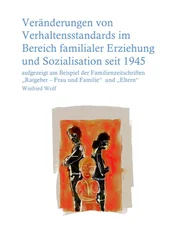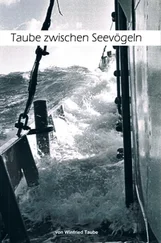seeks to get out, was assembled,
Grünewald, who in any case must have tended
towards an extremist view of the world,
will have come to see the redemption of the
living as one from life itself.
Now life as such, as it unfolds, dreadfully,
everywhere and at all times,
is not to be seen on the altar panels
whose figures have passed beyond
the miseries of existence, unless it be
in that unreal and demented thronging
which Grünewald has developed around
St. Anthony of the temptation:
dragged by his hair over the ground
by a gruesome monster.
Low down in the bottom-left corner
cowers the body, covered with
syphilitic chancres, of an inmate
of the Isenheim hospital. Above it
rises a two-headed and manyarmed
androgynous creature
about to finish off the saint
with a brandished jaw-bone.
On the right, a stilt-legged bird-like beast
which, with human arms,
holds a cudgel raised up. Behind
and beside this, towards the picture’s centre,
crab-clawed together, shark- and dragon-like
maws, rows of teeth, pug noses
from which snot flows, fin-shaped
clammy limp wings, hair and horns,
skin like entrails turned outwards,
excrescences of an entire life,
in the air, on land and in water.
To him, the painter, this is creation,
image of our insane presence
on the surface of the earth,
the regeneration proceeding
in downward orbits
whose parasitical shapes
intertwine, and, growing into
and out of one another, surge
as a demonic swarm
into the hermit’s quietude.
In this fashion Grünewald,
silently wielding his paintbrush,
rendered the scream, the wailing, the gurgling
and the shrieking of a pathological spectacle
to which he and his art, as he must have known,
themselves belong. The panic-stricken
kink in the neck to be seen
in all of Grünewald’s subjects,
exposing the throat and often turning
the face towards a blinding light,
is the extreme response of our bodies
to the absence of balance in nature
which blindly makes one experiment after another
and like a senseless botcher
undoes the thing it has only just achieved.
To try out how far it can go
is the sole aim of this sprouting,
perpetuation and proliferation
inside us also and through us and through
the machines sprung from our heads,
all in a single jumble,
while behind us already the green
trees are leaving their leaves and
bare, as often they appear in Grünewald’s
pictures, loom up into the sky,
the dead branches overlaid
with a moss-like glutinous substance.
The black bird that in its beak
carries a break-time meal
to St. Anthony on his site
in the desert may be the one with
the heart of glass, the bird
flying ever closer to us,
of which another prophet
of the last days announces
that it will shit into the sea
so that the water boils itself out,
that the earth trembles and the great city
with the iron tower stands in flames,
whilst the Pope squats in a barge
and darkness comes and
with it a yellow dust
that covers the land.
On the Basel Crucifixion of 1505
behind the group of mourners
a landscape reaches so far into the depth
that our eyes cannot see its limits.
A patch of brown scorched earth
whose contour like the head of a whale
or an open-mouthed leviathan
devours the pale green meadow plains,
and the marshily shining stretches
of water. Above it, pushed off
to behind the horizon, which step
by step grows darker, more glowering,
rise the hills of the prehistory
of the Passion.We see the gate
of the Garden of Gethsemane, the approach
of the henchmen and the kneeling figure of Christ
so reduced in size that in the
receding space the rushing
away of time can be sensed.
Most probably Grünewald painted
and recalled the catastrophic incursion
of darkness, the last trace of light
flickering from beyond, after nature,
for in the year 1502, when he was working
at Bindlach, below the Fichtelgebirge,
on the creation of the Lindenhardt altar,
on the first of October the moon’s shadow
slid over Eastern Europe from Mecklenburg
over Bohemia and the Lausitz to southern Poland,
and Grünewald, who repeatedly was in touch
with the Aschaffenburg Court Astrologer Johann Indagine,
will have travelled to see this event of the century,
awaited with great terror, the eclipse of the sun,
so will have become a witness to
the secret sickening away of the world,
in which a phantasmal encroachment of dusk
in the midst of daytime like a fainting fit
poured through the vault of the sky,
while over the banks of mist and the cold
heavy blues of the clouds
a fiery red arose, and colours
such as his eyes had not known
radiantly wandered about, never again to be
driven out of the painter’s memory.
These colours unfold as the reverse of
the spectrum in a different consistency
of the air, whose deoxygenated void
in the gasping breath of the figures
on the central Isenheim panel is enough
to portend our death by asphyxiation; after which
comes the mountain landscape of weeping
in which Grünewald with a pathetic gaze
into the future has prefigured
a planet utterly strange, chalk-coloured
behind the blackish-blue river.
Here in an evil state of erosion
and desolation the heritage of the ruining
of life that in the end will consume
even the stones has been depicted.
In view of this it seems to me
that the ice age, the glaringly white
towering of the summits in
the upper realm of the Temptation,
is the construction of a metaphysic
and a miracle like the one
in the year 352, when
at the height of the summer
snow fell
on the Esquiline
Hill in Rome.
In the spring of 1525 Grünewald
rode through April light and showers
to Windsheim, where from the workshop
of Jakob Seckler he had ordered
the crowning piece for an altar,
an intricate carving of finials
and figures, vine leaves and
various birds.While Seckler
put the last touch to his work,
Grünewald fell into conversation
with Barthel and Sebald Beham,
etchers and draughtsmen from Nürnberg who,
seized on January 12th as godless painters
and driven out of their native city for heresy,
were lodging provisionally at the Windsheim master’s.
The brothers, on walks out into the still
discoloured fields and till late into the night,
told of Thomas Münzer, at one time in Nürnberg,
now gone through Swabia to Alsace,
to Switzerland and into the Black Forest
to raise the insurrection. For the sixth
trumpet was about to sound and the poor
letter must be released from its prison.
With clangour a great
pentecost was to begin,
the filling of the waters well nigh
completed, the seething
planets gathered in
the house of Pisces. The red
star was drawing into conjunction
with Saturn, the sign
of the peasants, and a fantastic
fire would flare up when,
in the imminent future,
a needy wretch would be revealed
as the Messiah Septentrionalis.
Grünewald said that once, in his childhood,
he must have been six or seven,
Читать дальше
